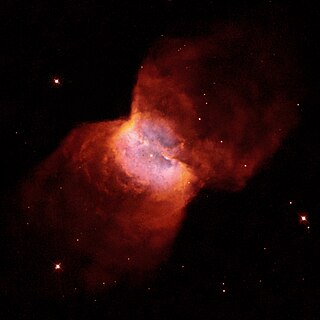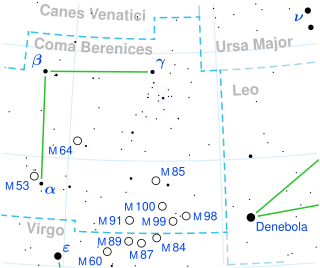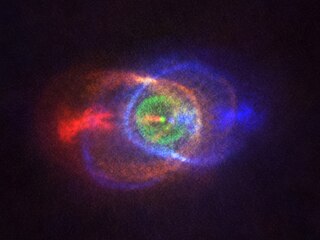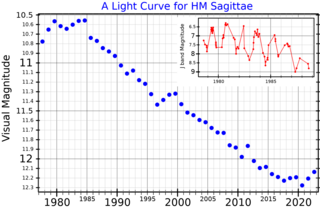
A planetary nebula is a type of emission nebula consisting of an expanding, glowing shell of ionized gas ejected from red giant stars late in their lives.

Coma Berenices is an ancient asterism in the northern sky, which has been defined as one of the 88 modern constellations. It is in the direction of the fourth galactic quadrant, between Leo and Boötes, and it is visible in both hemispheres. Its name means "Berenice's Hair" in Latin and refers to Queen Berenice II of Egypt, who sacrificed her long hair as a votive offering. It was introduced to Western astronomy during the third century BC by Conon of Samos and was further corroborated as a constellation by Gerardus Mercator and Tycho Brahe. It is the only modern constellation named for a historic person.

NGC 2346 is a planetary nebula near the celestial equator in the constellation of Monoceros, less than a degree to the ESE of Delta Monocerotis. It is informally known as the Butterfly Nebula. The nebula is bright and conspicuous with a visual magnitude of 9.6, and has been extensively studied. Among its most remarkable characteristics is its unusually cool central star, which is a spectroscopic binary, and its unusual shape.

Alpha Comae Berenices is a binary star in the constellation of Coma Berenices, 17.8 parsecs (58 ly) away. It consists of two main sequence stars, each a little hotter and more luminous than the Sun.

NGC 1514 is a planetary nebula in the zodiac constellation of Taurus, positioned to the north of the star Psi Tauri along the constellation border with Perseus. Distance to the nebula is 466 pc, according to GAIA DR2 data.

A bipolar outflow comprises two continuous flows of gas from the poles of a star. Bipolar outflows may be associated with protostars, or with evolved post-AGB stars.

NGC 2867 is an elliptical Type II planetary nebula in the southern constellation of Carina, just over a degree to the NNW of the star Iota Carinae. It was discovered by John Herschel on April 1, 1834. Herschel initially thought he might have found a new planet, but on the following night he checked again and discovered it had not moved. The nebula is located at a distance of 7,270 light-years from the Sun.

FK Comae Berenices is a variable star that varies in apparent magnitude between 8.14 and 8.33 over a period of 2.4 days. It is the prototype for the FK Comae Berenices class of variable stars. The variability of FK Com stars may be caused by large, cool spots on the rotating surfaces of the stars. This star is thought to be the result of a recent binary merger, resulting in a high rate of both spin and magnetic activity.

Little Ghost Nebula, also known as NGC 6369, is a planetary nebula in the constellation Ophiuchus. It was discovered by William Herschel.

12 Comae Berenices is a binary star system in the northern constellation of Coma Berenices. It is the brightest member of the Coma Star Cluster and is visible to the naked eye with an apparent visual magnitude of 4.80. Although listed as a suspected variable star, there is no photometric evidence of it being variable in luminosity. However, the radial velocity was found to be variable, as announced by W. W. Campbell in 1910. The first orbital solution was published by Vinter Hansen in the 1940s. It is a double-lined spectroscopic binary with an orbital period of 396.5 days and an eccentricity of 0.566.

NGC 1501 is a complex planetary nebula located in the constellation of Camelopardalis, it was discovered on the 27th August 1787 by William Herschel. It is also known as the Oyster Nebula.

NGC 6905, also known as the Blue Flash Nebula, is a planetary nebula in the constellation Delphinus. It was discovered by William Herschel in 1784. The central star is 14.0 mag. The distance of the nebula, as with most planetary nebulae, is not well determined and estimates range between 1.7 and 2.6 kpc.

NGC 6778 is a planetary nebula (PN) located about 10,300 light years away from the Sun in the equatorial constellation of Aquila. It is positioned 5° to the SSW of the prominent star Delta Aquilae. This nebula was discovered by German astronomer Albert Marth during the period 1863–1865. English astronomer John Herschel may have mistakenly catalogued it as NGC 6785, as nothing can be found now at the coordinates he gave for it. In the New General Catalogue it was described as a "small, elongated, ill-defined disc".

24 Comae Berenices is a triple star system in the northern constellation of Coma Berenices. It is visible to the naked eye, with the brightest component being an orange-hued star with an apparent visual magnitude of 5.03. The system is located at a distance of approximately 269 light-years from the Sun based on parallax, and is drifting further away with radial velocities of 3–5 km/s.

A post-common envelope binary (PCEB) or pre-cataclysmic variable is a binary system consisting of a white dwarf or hot subdwarf and a main-sequence star or a brown dwarf. The star or brown dwarf shared a common envelope with the white dwarf progenitor in the red giant phase. In this scenario the star or brown dwarf loses angular momentum as it orbits within the envelope, eventually leaving a main-sequence star and white dwarf in a short-period orbit. A PCEB will continue to lose angular momentum via magnetic braking and gravitational waves and will eventually begin mass-transfer, resulting in a cataclysmic variable. While there are thousands of PCEBs known, there are only a few eclipsing PCEBs, also called ePCEBs. Even more rare are PCEBs with a brown dwarf as the secondary. A brown dwarf with a mass lower than 20 MJ might evaporate during the common envelope phase and therefore the secondary is supposed to have a mass higher than 20 MJ.

V1794 Cygni is a single variable star in the northern constellation Cygnus. It has the identifier HD 199178 from the Henry Draper Catalogue; V1794 Cygni is its variable star designation. With an apparent visual magnitude of 7.24, it's too dim to be visible with the naked eye but can be seen with binoculars. V1794 is located at a distance of 367 light-years (113 pc) based on parallax measurements, but is drifting closer to the Sun with a radial velocity of −31 km/s. It lies superimposed over a region of faint nebulosity to the west of the North American Nebula.

Abell 63 is a planetary nebula with an eclipsing binary central star system in the northern constellation of Sagitta. Based on parallax measurements of the central star, it is located at a distance of approximately 8,810 light years from the Sun. The systemic radial velocity of the nebula is +41±2 km/s. The nuclear star system is the progenitor of the nebula and it has a combined apparent visual magnitude of 14.67. During mid eclipse the magnitude drops to 19.24.

HM Sagittae is a dusty-type symbiotic nova in the northern constellation of Sagitta. It was discovered by O. D. Dokuchaeva and colleagues in 1975 when it increased in brightness by six magnitudes. The object displays an emission line spectrum similar to a planetary nebula and was detected in the radio band in 1977. Unlike a classical nova, the optical brightness of this system did not rapidly decrease with time, although it showed some variation. It displays activity in every band of the electromagnetic spectrum from X-ray to radio.


















